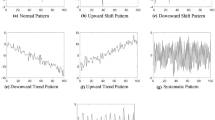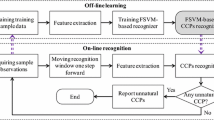Abstract
Identification of unnatural control chart patterns (CCPs) from manufacturing process measurements is a critical task in quality control as these patterns indicate that the manufacturing process is out-of-control. Recently, there have been numerous efforts in developing pattern recognition and classification methods based on artificial neural network to automatically recognize unnatural patterns. Most of them assume that a single type of unnatural pattern exists in process data. Due to this restrictive assumption, severe performance degradations are observed in these methods when unnatural concurrent CCPs present in process data. To address this problem, this paper proposes a novel approach based on singular spectrum analysis (SSA) and learning vector quantization network to identify concurrent CCPs. The main advantage of the proposed method is that it can be applied to the identification of concurrent CCPs in univariate manufacturing processes. Moreover, there are no permutation and scaling ambiguities in the CCPs recovered by the SSA. These desirable features make the proposed algorithm an attractive alternative for the identification of concurrent CCPs. Computer simulations and a real application for aluminium smelting processes confirm the superior performance of proposed algorithm for sets of typical concurrent CCPs.
Similar content being viewed by others
References
Chen Z., Lu S., Lam S. (2007) A hybrid system for SPC concurrent pattern recognition. Advanced Engineering Informatics 21(3): 303–310. doi:10.1016/j.aei.2007.03.002
Cheng C. S. (1997) A neural network approach for the analysis of control chart patterns. International Journal of Production Research 35(3): 667–697. doi:10.1080/002075497195650
Cook D. F., Chiu C. C. (1998) Using radial basis function neural networks to recognize shifts in correlated manufacturing process parameters. IIE Transactions 30(3): 227–234. doi:110.1023/A:1007426519770
DeVor R. E., Chang T. S., Sutherland J. W. (2007) Statistical quality design and control: Contempporary concepts and methods. Pearson Prentice Hall, New Jersey
Du, S., & Lv, J., & Xi, L. (2012). A robust approach for root causes identification in machining processes using hybrid learning algorithm and engineering knowledge. Journal of Intelligent Manufacturing (in press). doi:10.1007/s10845-010-0498-9.
Ebrahimzadeh A., Ranaee V. (2010) Control chart pattern recognition using an optimized neural network and efficient features. ISA Transactions 49(3): 387–393. doi:10.1016/j.isatra.2010.03.007
Elsner J., Tsonis A. A. (1996) Singular spectrum analysis: A new tool in time series analysis. Plenum Press, New York
Gauri S. (2010) Control chart pattern recognition using feature based learning vector quantization. International Journal of Advanced Manufacturing Technololy 48(9–12): 1061–1073. doi:10.1007/s00170-009-2354-7
Gauri S. K., Chakraborty S. (2007) A study on the various features for effective control chart pattern recognition. International Journal of Advanced Manufacturing Technology 34(3): 385–398. doi:10.1007/s00170-006-0591-6
Gu N., Xiang Y., Tan M., Cao Z. (2007) A new blind-equalization algorithm for an FIR SIMO system driven by MPSK signal. IEEE Transactions on Circuits and Systems-II Express Briefs 54(3): 227–231. doi:10.1109/TCSII.2006.888734
Gu N., Nahavandi S., Yu W., Creighton D. (2011) Family of blind source separation methods based on generalised constant modulus criterion. Electronics Letters 47(10): 595–597. doi:10.1049/el.2011.0758
Guh R. (2008) Real-time recognition of control chart patterns in autocorrelated processes using a learning vector quantization network-based approach. International Journal of Production Research 46(14): 3959–3991. doi:10.1080/00207540601011501
Guh R., Tannock J. (1999) A neural network approach to characterize pattern parameters in process control charts. Journal of Intelligent Manufacturing 10(5): 449–462. doi:10.1023/A:1008975131304
Hwarng H. B., Chong C. W. (1995) Detecting process non-randomness through a fast and cumulative learning art-based pattern recognizer. International Journal of Production Research 33(7): 1817–1833. doi:10.1080/00207549508904783
Hyvärinen A. (1999) Fast and robust fixed-point algorithms for independent component analysis. IEEE Transactions on Neural Networks 10(3): 626–634. doi:10.1109/72.761722
Hyvärinen A., Oja E. (1997) A fast fixed-point algorithm for independent component analysis. Neural Computation 9(7): 1483–1492. doi:10.1162/neco.1997.9.7.1483
Jiang P., Liu D., Zeng Z. (2009) Recognizing control chart patterns with neural network and numerical fitting. Journal of Intelligent Manufacturing 20(6): 625–635
Kvande H. (1993) Process control of aluminium reduction cells. In: Grjotheim K., Kvande H. (eds) Introduction to aluminium electrolysis: Understanding the Hall-Herloult process. Aluminium-Verlag, Dusseldorf
Kohonen T. (1984) Self organization and associate memories. Springer, New York
Kohonen T. (1997) Self-organizing maps. Springer, New York
Lu, C. (2012). An independent component analysis-based disturbance separation scheme for statistical process monitoring. Journal of Intelligent Manufacturing (in press). doi:10.1007/s10845-010-0394-3.
Lu C. J., Shao Y. E., Li P. H. (2011) Mixture control chart patterns recognition using independent component analysis and support vector machine. Neurocomputing 74(11): 1908–1914. doi:10.1016/j.neucom.2010.06.036
Montgomery D. C. (1996) Introduction to statistical quality control. Wiley, New York
Nelson L. S. (1984) The shewhart control chart—tests for special causes. Journal of Quality Technology 16(4): 237–239
Penland C., Weickmann K. M. (1991) Adaptive filtering and maximum entropy spectra with application to changes in atmospheric angular momentum. Journal of Geophysical Research 96(D12): 22659–22671
Perry M. B., Spoerre J. K., Velasco T. (2001) Control chart pattern recognition using back propagation artificial neural networks. International Journal of Production Research 39(15): 3399–3418. doi:10.1080/00207540110061616
Pham D., Oztemel E. (1994) Control chart pattern recognition using learning vector quantization networks. International Journal of Production Research 32(3): 721–729. doi:10.1080/00207549408956963
Pham, D., & Sahrana, S. (2006). Control chart pattern recognition using spiking neural networks, In Proceedings of 2nd I*PROMS Virtual international conference (pp.~319–325). doi:10.1016/B978-008045157-2/50059-6.
Plummer J. (1993) Tighter process control with neural networks. AI Expert 8(10): 49–55
Ranaee V., Ebrahimzadeh A. (2011) Control chart pattern recognition using a novel hybrid intelligent method. Applied Soft Computing 11(2): 2676–2686. doi:10.1016/j.asoc.2010.10.016
Ruelle D. (1980) Strange attractors. The Mathematical Intelligencer 2(1): 126–137
Takens F. (1981) Dynamical systems and turbulence. In: Rand D. A., Young L.-S. (eds) Detecting strange attractors in turbulence. Springer, New York, pp 366–381
Tonazzini A., Gerace I., Martinelli F. (2010) Multichannel blind separation and deconvolution of images for document analysis. IEEE Transactions on Image Processing 19(4): 912–925. doi:10.1109/TIP.2009.2038814
Wang C., Kuo W. (2007) Identification of control chart patterns using wavelet filtering and robust fuzzy clustering. Journal of Intelligent Manufacturing 18(3): 343–350. doi:10.1007/s10845-007-0028-6
Wang C., Kuo W., Qi H. (2007) An integrated approach for process monitoring using wavelet analysis and competitive neural network. International Journal of Production Research 45(1): 227–244. doi:10.1080/00207540500442393
Wang C., Dong T., Kuo W. (2009) A hybrid approach for identification of concurrent control chart patterns. Journal of Intelligent Manufacturing 20(4): 409–419. doi:10.1007/s10845-008-0115-3
Western Electric. (1956). Statistical quality control handbook. Western Electric Corporation. Indianapolis: Indiana.
Xiang Y., Nguyen V., Gu N. (2006) Blind equalization of nonirreducible systems using the cm criterion. IEEE Transactions On Circuits and Systems II-Express Briefs 53(8): 758–762. doi:10.1109/TCSII.2006.875382
Yang M., Yang J. (2002) A fuzzy-soft learning vector quantization for control chart pattern recognition. International Journal of Production Research 40(12): 2721–2731. doi:10.1080/00207540210137639
Yang S. F. (2010) Process control using VSI cause selecting control charts. Journal of Intelligent Manufacturing 21(6): 853–867. doi:10.1007/s10845-009-0261-2
Yu T., Hassen J. (2010) Automatic beamforming for blind extraction of speech from music environment using variance of spectral flux-inspired criterion. IEEE Journal of Selected Topics in Signal Processing 4(5): 785–797. doi:10.1109/JSTSP.2010.2069790
Author information
Authors and Affiliations
Corresponding author
Rights and permissions
About this article
Cite this article
Gu, N., Cao, Z., Xie, L. et al. Identification of concurrent control chart patterns with singular spectrum analysis and learning vector quantization. J Intell Manuf 24, 1241–1252 (2013). https://doi.org/10.1007/s10845-012-0659-0
Received:
Accepted:
Published:
Issue Date:
DOI: https://doi.org/10.1007/s10845-012-0659-0




